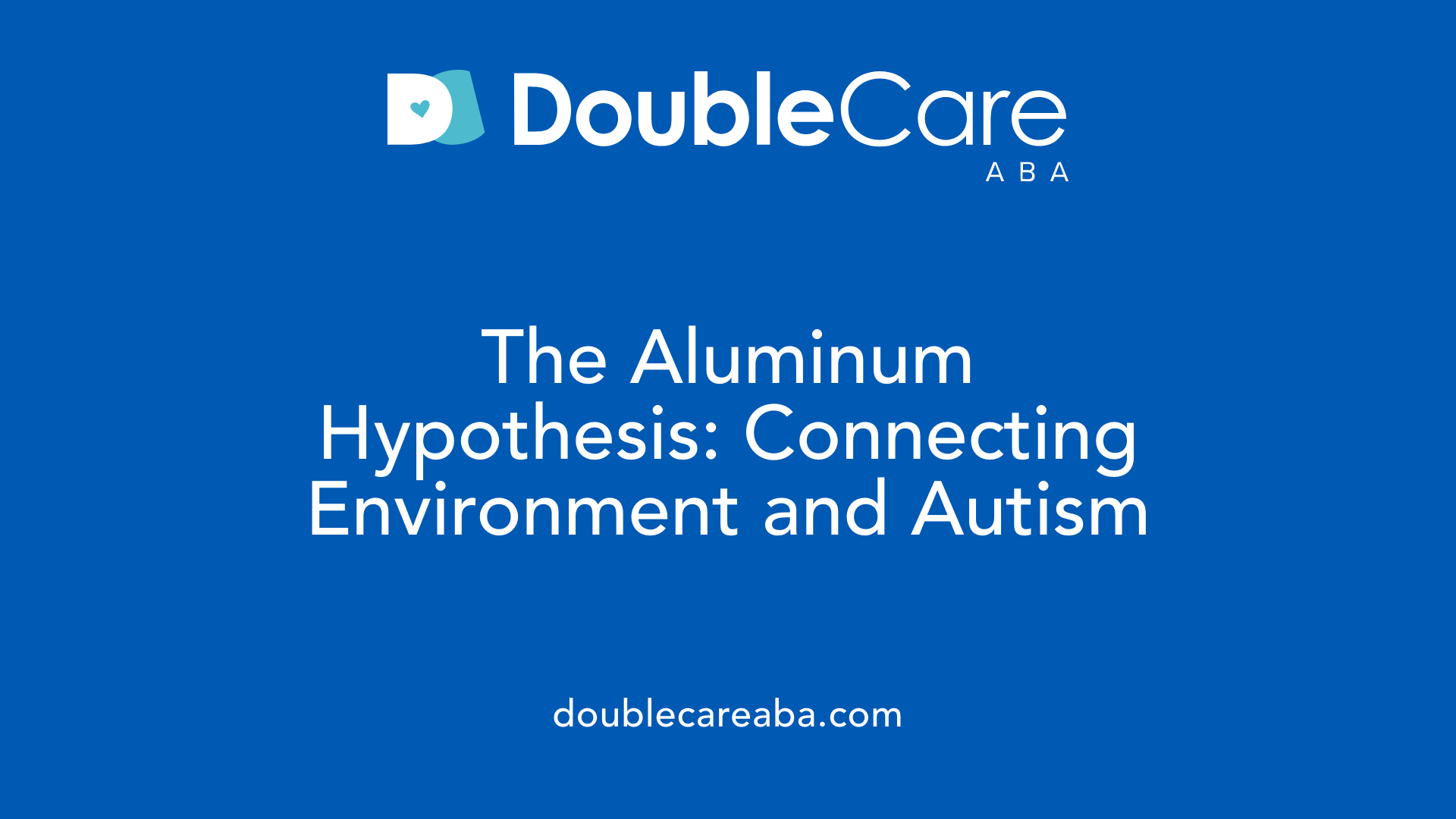Exploring a Complex Question
The potential causes of autism spectrum disorder (ASD) remain an area of active research and debate. Among numerous environmental factors considered, aluminum has emerged as a substance of interest due to findings of elevated aluminum in brain tissues of individuals diagnosed with ASD. This article delves into current scientific evidence surrounding aluminum's possible role in autism, the controversies linked to vaccine adjuvants containing aluminum, and how behavioral therapies like Applied Behavior Analysis (ABA) remain central to treatment.
Understanding Autism and Environmental Factors: The Aluminum Hypothesis

What is the Etiology of Autism Spectrum Disorder?
Autism spectrum disorder (ASD) is a neurodevelopmental condition with no single known cause. Both genetic and environmental factors are believed to influence its onset. Understanding these diverse influences is crucial to unraveling ASD's complex nature.
Could Environmental Toxins Like Aluminum Be Linked to ASD?
Among various environmental toxins studied, aluminum has drawn attention in autism research. Studies reveal unusually high aluminum concentrations in the brains of individuals with ASD. This raises questions about aluminum’s potential involvement in the disorder.
How Is Aluminum Detected in the Brains of Individuals with Autism?
Recent studies have employed advanced techniques such as transversely heated graphite furnace atomic absorption spectrometry to measure aluminum levels in brain tissue. Results demonstrate consistently elevated aluminum content, especially in the occipital lobe, compared to typical brain levels.
What Does Aluminum’s Presence in Brain Cells Imply?
Using fluorescence microscopy with aluminum-selective dyes, researchers found aluminum located inside neurons and within microglia-like inflammatory cells. This intracellular accumulation suggests aluminum might contribute to inflammatory processes within the autistic brain.
Are There Proposed Mechanisms for Aluminum’s Neurotoxicity?
Experimental findings show that aluminum injections can induce behavioral changes in animal models, supporting its neurotoxic potential. Potential mechanisms include aluminum-triggered neuroinflammation and disruption of cellular function.
What Does Research Say About Aluminum and ASD Risk?
While elevated brain aluminum is observed in autism, large epidemiological studies, including a 24-year Danish study of over 1.2 million children, found no association between aluminum-containing vaccines and ASD or other neurodevelopmental disorders. This highlights the complexity and need for further research to clarify causality.
| Aspect | Findings in ASD Individuals | Research Insights |
|---|---|---|
| Aluminum Levels in Brain | Consistently high, especially in occipital lobe | Measured via sensitive atomic absorption techniques |
| Cell Types Containing Aluminum | Neurons and microglia-like inflammatory cells | Suggests involvement in neuroinflammation |
| Neurotoxic Evidence | Behavioral changes in mice with aluminum exposure | Supports potential role in ASD pathology |
| Epidemiological Data | No association found between aluminum vaccine exposure and ASD | Large-scale cohort studies with extensive follow-up |
Overall, the presence of elevated aluminum in autistic brains alongside potential neurotoxic effects underscores the importance of continued investigation into environmental contributors to ASD.
Examining Epidemiological Evidence: Vaccines, Aluminum Adjuvants, and Autism Risk

Is there evidence that aluminum in vaccines causes autism?
A comprehensive 24-year Danish cohort study involving over 1.2 million children investigated whether early childhood exposure to aluminum-containing vaccines increased the risk of autism spectrum disorder (ASD) or other neurodevelopmental conditions.
The study followed children from birth to age 2 for vaccine exposure, with a median follow-up age of 5 years for health outcomes. It found that almost all children—98.8%—received aluminum-adjuvanted vaccines, exposing them to a median aluminum dose of 3 mg by age 2.
Importantly, the researchers evaluated 50 chronic conditions across autoimmune, allergic, atopic, and neurodevelopmental disorders. Hazard ratios for all these conditions, including ASD, were close to 1 with confidence intervals that did not support any significant increased risk. This robust epidemiological data strongly argues against a causal link between aluminum in vaccines and autism.
While some ecological observations note a correlation between increasing numbers of vaccines (with aluminum adjuvants) and rising ASD rates globally, correlation does not establish causation. High-quality, long-term population studies like this Danish cohort provide the most reliable evidence currently available, pointing to no increased risk from vaccine aluminum exposure.
These findings are critical in addressing public concerns about vaccine safety and autism. They support the continued use of aluminum-containing adjuvants in vaccines, which remain essential for effective immunization programs worldwide.
Experimental Insights: Aluminum's Neurotoxic Effects in Animal Models

What experimental evidence suggests aluminum could impact neurodevelopment?
Animal research provides important clues about aluminum's impact on the nervous system. Studies where aluminum is injected into mice have shown notable behavioral changes that point to neurotoxic effects. These behavioral shifts often resemble symptoms related to neurological dysfunction, highlighting aluminum's potential to disrupt normal brain activity.
Mechanisms underlying aluminum's neurotoxicity
The neurotoxic potential of aluminum is supported by several biological mechanisms revealed in experimental models. Aluminum can accumulate inside brain cells, including neurons and glial cells, promoting inflammation and oxidative stress. This cellular stress can impair neural communication and trigger immune responses, which may contribute to cognitive and behavioral deficits.
Implications for understanding autism spectrum disorder
Given these findings, animal models provide a biological basis to investigate how elevated aluminum exposure might influence neurodevelopment in humans. The detection of increased aluminum concentrations in the brains of individuals with autism aligns with the neurotoxic effects observed in mice, suggesting a possible role for aluminum in ASD pathology.
Supporting research on aluminum's neurotoxic potential
Beyond behavioral observations, comprehensive studies outline multiple pathways—such as immune activation and neuronal damage—through which aluminum may affect brain development. Together, these data underscore the importance of further research to clarify aluminum's role in neurodevelopmental disorders and assess its contribution to rising ASD prevalence.
| Aspect | Details | Relevance to ASD Research |
|---|---|---|
| Behavioral changes in mice | Injection of aluminum induces symptoms resembling neurotoxicity | Models neurological dysfunction potentially linked to ASD |
| Neurotoxic mechanisms | Cellular accumulation, inflammation, oxidative stress, immune activation | Explains possible pathophysiological effects contributing to ASD |
| Human brain aluminum data | Elevated aluminum found in autism brain tissues | Supports correlation between aluminum and ASD pathology |
| Research implications | Animal studies demonstrate biological plausibility for aluminum's role in neurodevelopment | Guides future investigations and risk assessment for environmental exposure |
The Role of Applied Behavior Analysis (ABA) Therapy in Autism Treatment

What is Applied Behavior Analysis (ABA) therapy and how is it used in treating autism?
Applied Behavior Analysis (ABA) therapy is a scientifically supported treatment that focuses on how environmental factors affect behavior. It works by breaking down complex skills into small, manageable steps and using positive reinforcement to encourage desirable behaviors while reducing challenging behaviors. ABA techniques often involve analyzing what happens before and after a behavior (the ABC framework), prompting, and structured approaches like Discrete Trial Training. The therapy is tailored to each individual's needs and targets skills such as communication, social interaction, and self-care.
What are some common techniques used in ABA therapy?
Common ABA methods include:
- Positive and negative reinforcement
- Visual modeling
- Prompting with gradual fading
- Behavior chaining to teach complex tasks
- Behavior contracts
- Extinction of unwanted behaviors
- Modeling and redirection
- Script fading to boost social independence These techniques are combined and personalized to promote learning and functional improvements.
How effective is ABA therapy in improving behavioral outcomes for individuals with autism?
Research shows that ABA therapy can greatly enhance communication, social skills, and daily living abilities, especially when started early and delivered intensively. While it may not completely change core autism symptoms, ABA fosters meaningful, lasting benefits and reduces problem behaviors through positive reinforcement and naturalistic teaching.
Who typically provides ABA therapy, and what qualifications do these professionals have?
ABA is usually delivered by trained professionals such as Board Certified Behavior Analysts (BCBAs) and Registered Behavior Technicians (RBTs). BCBAs complete graduate education and supervised internships and pass certification exams. RBTs receive focused training and work under supervision. These providers use evidence-based strategies tailored to individual needs while maintaining ethical standards and accurate data collection.
How can families access ABA therapy services?
Families may access ABA therapy through referrals or autism diagnoses from healthcare providers. Early intervention programs offered by schools or state agencies also provide services. Parents can self-refer for evaluations and collaborate with educational institutions to develop Individualized Education Plans (IEPs) or 504 plans including ABA. Insurance coverage can vary, so exploring both public and private options is essential to finding suitable therapy.
Are there any criticisms or controversies surrounding ABA therapy?
Criticism of ABA centers on its past use of harsh methods aimed at normalizing behavior, which sometimes caused distress. Some argue that suppressing behaviors like stimming may harm coping mechanisms important for autistic individuals. Ethical concerns include questions of autonomy, respect for neurodiversity, and the quality of some service providers. Modern ABA emphasizes positive and respectful methods, but challenges remain in ensuring ethical and high-quality interventions.
Reconciling Evidence and Concerns: Aluminum Exposure and Autism in Perspective
What is the current consensus on aluminum causing autism?
Scientific investigations have revealed a complex picture regarding aluminum and autism spectrum disorder (ASD). Notably, brain tissue analyses from individuals with autism consistently show elevated aluminum levels, including some of the highest recorded in human brain tissue, particularly in the occipital lobe. Fluorescence microscopy further identifies aluminum localization within neurons and inflammatory brain cells, suggesting potential neurotoxic effects.
How do tissue studies compare with epidemiological data?
Contrasting these biochemical findings, large-scale epidemiological studies provide critical context. For example, a comprehensive 24-year Danish study involving over 1.2 million children evaluated exposure to aluminum-containing vaccines and found no increased risk of ASD or other chronic conditions. Hazard ratios near 1 indicate a lack of causal association between aluminum adjuvants in vaccines and neurodevelopmental disorders.
What are the nuances of environmental exposure?
Environmental exposure to aluminum can occur via multiple pathways beyond vaccination, including everyday environmental toxins. Animal studies demonstrate that injected aluminum can induce behavioral changes, supporting its neurotoxic potential, though translating these findings to humans remains complex. The apparent discordance may stem from differences in exposure routes, dosages, or individual susceptibility shaped by genetic and multifactorial influences.
Why is ongoing research important?
Given these contradictions, ongoing research is essential to deepen understanding of aluminum’s role, if any, in ASD pathology. Studies integrating exposure sources, genetic factors, and detailed neurobiological mechanisms are crucial to unraveling this multifaceted issue.
What should public health messaging emphasize?
Public health communications must balance acknowledging legitimate scientific inquiry into aluminum’s effects while dispelling misinformation. Evidence-based messaging affirms vaccine safety and highlights the current consensus that aluminum exposure via vaccines does not cause autism, helping to sustain public confidence and informed decision-making.
Future Directions in Autism Research and Treatment Approaches

Why is integrated research important in autism?
Integrated research combining genetics, environmental science, and clinical studies is crucial for unraveling autism spectrum disorder (ASD) complexities. Collaborative efforts enable a comprehensive understanding of how factors like genetics and environmental exposures—such as aluminum in brain tissue—interact to influence ASD development. This integration helps avoid isolated conclusions and supports targeted prevention and intervention.
What recent advances have been made regarding environmental risk factors?
Recent studies have highlighted environmental toxins like aluminum as potential ASD contributors. Elevated aluminum levels have been consistently found in brain tissues of individuals with autism, particularly in regions such as the occipital lobe. Investigations using fluorescence microscopy have shown aluminum's presence in neurons and inflammatory cells, suggesting neurotoxic effects. At the same time, large epidemiological research has found no causal link between aluminum in vaccines and ASD, emphasizing the necessity to discern exposure routes and underlying mechanisms.
How can therapeutic outcomes be improved?
Advancements in understanding the role of environmental factors pave the way for personalized interventions addressing specific neuroinflammatory or toxic profiles. Therapeutic strategies aiming to reduce aluminum accumulation or mitigate related neuroinflammation may benefit individuals. Moreover, prioritizing early detection and multidisciplinary support can enhance cognitive and social development.
How should research efforts and treatment approaches be balanced?
Balancing curiosity-driven research with evidence-based therapies is essential. While exploring controversial risk factors like aluminum exposure continues, it is vital to avoid misinformation that could affect public health decisions, like vaccine hesitancy. Rigorous scientific validation alongside compassionate support for autistic individuals ensures progress without compromising safety.
Why is supporting autistic individuals and families a priority?
Beyond research and treatment, empowering autistic people and their families through access to resources, education, and community is key to improved quality of life. Recognizing diverse experiences within the spectrum encourages tailored support and reduces stigma. Ongoing dialogue between scientists, clinicians, and advocacy groups fosters a holistic approach to managing ASD challenges.
Balancing Concern and Care in Autism Understanding and Treatment
The question of whether aluminum causes autism remains complex, with findings from brain tissue studies suggesting possible involvement but large-scale epidemiological research disproving links with vaccine-derived aluminum exposure. Meanwhile, effective autism therapies, notably Applied Behavior Analysis, continue to support individuals and families in developing essential skills and improving quality of life. Ongoing research must continue to explore environmental factors while emphasizing evidence-based treatments and respecting neurodiversity. Ultimately, informed dialogue and compassionate care remain central to addressing autism comprehensively.
References
- Aluminium in brain tissue in autism
- No link between aluminum-adjuvanted childhood vaccines, ...
- Reviewing the association between aluminum adjuvants in ...
- What to Consider When Looking for a Qualified ABA Provider
- Accessing Services for Autism Spectrum Disorder
- Applied Behavioral Analysis (ABA) Therapy
- The effectiveness of applied behavior analysis program ...
- Applied Behavior Analysis (ABA)
- Efficacy of Interventions Based on Applied Behavior ...














